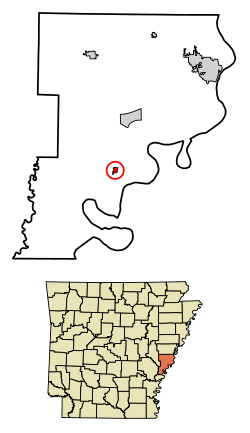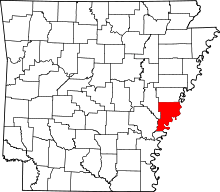Elaine, Arkansas
| Elaine, Arkansas | |
|---|---|
| City | |
 Location of Elaine in Phillips County, Arkansas. | |
| Coordinates: 34°18′31″N 90°51′15″W / 34.30861°N 90.85417°WCoordinates: 34°18′31″N 90°51′15″W / 34.30861°N 90.85417°W | |
| Country | United States |
| State | Arkansas |
| County | Phillips |
| Area[1] | |
| • Total | 0.51 sq mi (1.32 km2) |
| • Land | 0.51 sq mi (1.32 km2) |
| • Water | 0.00 sq mi (0.00 km2) |
| Elevation | 167 ft (51 m) |
| Population (2010) | |
| • Total | 636 |
| • Estimate (2017)[2] | 527 |
| • Density | 1,029.30/sq mi (397.78/km2) |
| Time zone | UTC-6 (Central (CST)) |
| • Summer (DST) | UTC-5 (CDT) |
| ZIP code | 72333 |
| Area code(s) | 870 |
| FIPS code | 05-20950 |
| GNIS feature ID | 0048832 |
Elaine (pronounced locally with the accent on the first syllable) is a very small city in Phillips County, Arkansas, United States, in the delta of the Mississippi River. The population was 865 at the 2000 census.
It is best known as the location of the Elaine massacre of September 30–October 1, 1919, in which an estimated 237 Black people were killed in the rural county by rampaging white mobs. Five whites died in the events. This was one of the worst incidents of racial and labor violence in American history. Black sharecroppers were attempting to organize a farmers' union, which the planters resisted.[3]
History
Phillips County was developed in the antebellum years for cotton plantations, which relied on the labor of large gangs of enslaved African Americans. Their work produced the wealth of the major large planters. Cotton continued to be the major commodity crop into the 20th century in this area but after the war, blacks preferred to work as sharecroppers or tenant farmers. By the turn of the century, Arkansas and other southern states had disenfranchised most blacks, excluding them from the political system, and imposed Jim Crow. But black sharecroppers began to try to organize a farmers' union after World War I. They were seeking better conditions of payment and accounting from white landowners of the area cotton plantations. Whites resisted any change and often tried to break up there meetings.
On September 30, 1919, two white men, including a local deputy, tried to break up a meeting of black sharecroppers who were trying to organize a farmers' union. After a white deputy was killed in a confrontation with guards at the meeting, word spread to town and around the area. Hundreds of whites from Phillips and neighboring areas rushed to suppress the blacks, and started attacking blacks at large. Governor Charles Hillman Brough requested federal troops to stop what was called the Elaine Race Riot. White mobs spread throughout the county, killing an estimated 237 blacks before most of the violence was suppressed after October 1. Five whites also died in the incident. The governor accompanied the troops to the scene; their use had been approved by U.S. President Woodrow Wilson. Sharecroppers generally remained at a disadvantage in dealing with white landowners.
The county continues to rely on agriculture, but mechanization reduced the need for farm labor. Many African Americans left this area in the Great Migration of the early 20th century. In the 21st century, most farms are industrial scale. Some seasonal Hispanic migrant workers have been hired in this area since the late 20th century.
At 6:15 PM, April 26, 2011, a tornado – part of the 2011 Super Outbreak – hit the Elaine area.[4] The tornado was classified as an EF-0, with estimated wind speeds of 75 miles per hour (121 km/h; 65 kn).[4] The tornado's path of destruction was 200 yards (180 m) wide and the tornado traveled a path of 21.5 miles (34.6 km) along Highway 61 and across the Mississippi state line, ending near Lula, Mississippi.[4] Most of the tornado's damage was concentrated in Friars Point and Coahoma, Mississippi.[4]
Geography
Elaine is located at 34°18′31″N 90°51′15″W / 34.30861°N 90.85417°W (34.308595, −90.854201).[5]
According to the United States Census Bureau, the city has a total area of 0.5 square miles (1.3 km2), all land.
Demographics
| Historical population | |||
|---|---|---|---|
| Census | Pop. | %± | |
| 1920 | 377 | — | |
| 1930 | 511 | 35.5% | |
| 1940 | 634 | 24.1% | |
| 1950 | 744 | 17.4% | |
| 1960 | 898 | 20.7% | |
| 1970 | 1,210 | 34.7% | |
| 1980 | 991 | −18.1% | |
| 1990 | 846 | −14.6% | |
| 2000 | 865 | 2.2% | |
| 2010 | 636 | −26.5% | |
| Est. 2017 | 527 | [2] | −17.1% |
| U.S. Decennial Census[6] 2014 Estimate[7] | |||
As of the census[8] of 2000, there were 865 people, 330 households, and 222 families residing in the city. The population density was 1,725.8 people per square mile (668.0/km²). There were 356 housing units at an average density of 710.3 per square mile (274.9/km²). The racial makeup of the city was 39.08% White, 58.15% Black or African American, 0.92% from other races, and 1.85% from two or more races. 6.01% of the population were Hispanic or Latino of any race. Agriculture includes rice production, which uses seasonal migrant laborers from Mexico and Latin America in the town, nearby Lake View, and the Helena area.
There were 330 households out of which 31.8% had children under the age of 18 living with them, 34.2% were married couples living together, 30.3% had a female householder with no husband present, and 32.7% were non-families. 31.2% of all households were made up of individuals and 18.5% had someone living alone who was 65 years of age or older. The average household size was 2.62 and the average family size was 3.31.
In the city, the population was spread out with 31.8% under the age of 18, 10.8% from 18 to 24, 19.5% from 25 to 44, 21.2% from 45 to 64, and 16.8% who were 65 years of age or older. The median age was 32 years. For every 100 females, there were 80.2 males. For every 100 females age 18 and over, there were 73.5 males.
The median income for a household in the city was $19,479, and the median income for a family was $22,813. Males had a median income of $22,386 versus $18,056 for females. The per capita income for the city was $12,640. About 33.5% of families and 41.1% of the population were below the poverty line, including 59.1% of those under age 18 and 26.5% of those age 65 or over.
Notable people
- John Hughey, country musician
- Levon Helm, musician
- Barry Williamson, Texas politician, was reared in Elaine.
Education
The Marvell–Elaine School District serves the community. Marvell Primary School and Marvell High School in Marvell serve Elaine.[9]
Previously the Elaine School District served the community. On July 1, 2006, the Elaine district merged into the Marvell district.[10] When the district existed, it operated Lucilia Wood Elementary School and Elaine High School.[11][12]
References
- ↑ "2017 U.S. Gazetteer Files". United States Census Bureau. Retrieved Aug 22, 2018.
- 1 2 "Population and Housing Unit Estimates". Retrieved March 24, 2018.
- ↑ "US Map of 73 years of lynching", New York Times, 10 February 2015
- 1 2 3 4 NWS Memphis Office Report
- ↑ "US Gazetteer files: 2010, 2000, and 1990". United States Census Bureau. 2011-02-12. Retrieved 2011-04-23.
- ↑ "Census of Population and Housing". Census.gov. Archived from the original on May 12, 2015. Retrieved June 4, 2015.
- ↑ "Annual Estimates of the Resident Population for Incorporated Places: April 1, 2010 to July 1, 2014". Retrieved June 4, 2015.
- ↑ "American FactFinder". United States Census Bureau. Archived from the original on 2013-09-11. Retrieved 2008-01-31.
- ↑ "Schools." Marvell-Elaine School District. Retrieved on March 2, 2011.
- ↑ "Consolidation/Annexations of LEA's (1983–2010) Archived September 24, 2010, at the Wayback Machine.." Arkansas Department of Education. Retrieved on March 2, 2011.
- ↑ "Lucilia Wood Elementary School." Information Network of Arkansas (State of Arkansas). Retrieved on March 2, 2011. "100 College St. Elaine, AR 72333"
- ↑ "Elaine high School." Information Network of Arkansas (State of Arkansas). Retrieved on March 2, 2011. "100 College St. Elaine, AR 72333"
